Sushi Yoshitake
Before your meal begins were are advised to eat the sushi immediately after it is presented because the temperature of the "shari" sushi rice is adjusted by the chef for different fish (!!!) so, the sushi is tastiest immediately after serving.
Setting.
Appetizers
Koubako crab.
The crab with sotoko jelly. There are 2 kinds of eggs in crab, uchiko and sotoko. Uchiko is the ovary which is inside of the shell. Sotoko is fertilized egg.
Fabulously tender and succulent, very slow cooked octopus. The chef's technique in preparing this octopus was impeccable, creating a unique texture.
The season for salmon roe. There is no salmon roe you can buy in a jar that can hold a candle to roe this fresh, with virtually no salt.
Wonderfully tender, very fresh, steamed abalone accompanied by abalone liver sauce (the best version of abalone liver I have ever experienced).
Hay smoked and seared bonito sashimi with wasabe and ginger. This was so tasty/good that it was the only one that I requested a second portion, at the end.
Steamed egg custard with crab (no photo).
Nigiri (Sushi, Fish On Pressed Vinegared Rice):
No soy sauce was provided, only seaweed sauce and salt.
No soy sauce was provided, only seaweed sauce and salt.
Chef at work.
Squid being prepared over bincho charcoal.
Ink squid.
Wonderful sea bream.
Chu-toro, medium fatty tuna.
O-toro, the best (for me) (most fatty) part of the tuna belly. Here, it was incredibly fresh and flavourful, with wonderful firm texture (often, in North America, o-toro has a somewhat mushy texture).
Gizzard shad.
Ark shell (akagai), perhaps the best experience of this shellfish in my experience. Plump texture, sweet and remarkably fresh.
Sea urchin, topped with ash for flavour.
Prawn (kuruma-ebi).
Sea eel.
Bamboo leaves on which the eel was grilled.
Sea eel sushi.
Preparing a chopped tuna hand roll with rice and roasted nori.
The maguro tuna for the hand roll.
The hand roll.
Tamago (sweet Japanese style omelette served room temperature, like a firm egg custard), a typical conclusion of the meal.
Soup (no photo).
Ippudo Ramen
Ippudo also has a branch in New York and is my fave ramen spot there.
Shiromaru ramen is Ippudo's original tonkatsu ramen. The rich and fragrant porky broth is a very slow reduction of pork bones and other secret porky ingredients that are reduced over an 18 hour period and then left to "mature" for 24 hours to extract the savory intense pork flavours. Traditionally the broth is served with Hakata style thin, straight noodles.
My bowl of ramen with topping of bean sprouts, spring onion, seaweed and crushed raw garlic which is provided, with crusher, at your table.
The raw garlic and pickled daikon.
More fermented condiments.
Sushi Mitzutani
Sushi Mitzutani is a very "serious" restaurant with about 8 seats. Conversation is not encouraged. NO photographs. The chef never smiles or looks away from what he is concentrating on. He is very serious about his craft. Chef Mitzutani previously trained at michelin 3*** Jiro (the chef on which the movie was based). Reservations must be made months ahead and only by a Japanese person, preferably with a house familiar patron making the introduction and reservation.
So, because no photos were allowed I will cite each dish.
Appetizers 1,
flounder
2,
abalone
3,
mackerel
Nigiri 1, gizzard shad
2,
lean tuna (maguro)
3,
middle fatty tuna (chu-toro)
4,
fatty tuna (o-toro), great quality melt-in-the-mouth tuna.
5,
ligament of surf clam
6,
pacific geoduck clam (mirugai)
7,
ark shell
8,
halfbeak
9,
horse mackerel
10,
prawn
11,
sea urchin
12,
sea eel
13,
gourd strip roll
Chef Mitzutani is considered a master at making rice, and, his rice was indeed a wonderful texture and seemed to be at a good temperature for the fish. The vinegar aspect was subtle and very flattering for the fish.
The courses are simple in their presentation. There is no originality or "creativity" in what is presented, such as at Sushi Sawada (will discuss later). The drama is all about the masterful presentation of exceptional quality seafood.
Please be aware, this restaurant accepts cash only.
Matsukawa
Matsukawa is a by invitation only kaiseki restaurant. Invitation only means that a familiar patron of the restaurant must make your reservation. The restaurant takes cash only. Matsukawa is considered by many, one of the top 2 or 3 kaiseki restaurants in Tokyo. It only has 7 counter seats.
We enjoyed Daiginjyo Higan,
Senshin sake with our meal.
We were presented with perilla tea.
The tokonoma, alcove of honour.
Taiza crab. Snow crab (= Zuwai crab) has different names depending
on the area and the port where the crab are landed. Taiza crab is one kinds of
snow crab. It is said that Taiza is the best Snow crab because the port of Taiza
is so close to the fishing grounds, so it is remarkably fresh and of great quality. The
catch is extremely limited because there are only 4 fishing boats in Taiza.
Taiza crab leg.
Clams and rice, called Iimushi.
Sea
bream sashimi.
Taiza
crab ball in soup topped with yuzu zest and rind..
Threadsail
file fish served with its liver.
Dried mullet roe on a bed of daikon puree.
Taiza
crab sashimi presented on its shell.
Mana
bonito.
Duck
with fried leek.
Just harvested buckwheat made into noodles topped with matsutake mushrooms and grated daikon.
Turnip
and sea cucumber ovary (not raw).
Chinese pickled cabbage.
The presentation of fresh salmon roe, nori seaweed, raw mullet roe and simmered whitebait.
The simmered whitebait.
The most exceptionally fresh salmon roe with bright clear flavours. For anyone with previous salmon roe experience outside of Japan, these flavours are almost addictive. At another restaurant, we were given a big bowl of the same and frankly, I could not stop helping myself to more.
Nori.
Raw mullet roe.
Rice and miso soup served with the Chinese pickled cabbage.
I made some rice, salmon roe and nori to be eaten together.
Baked chestnut.
Grapefruit
jelly and persimmon from Kumamoto Prefecture.
Harutaka
Chef Harutaka Takahashi began his career with the remarkably well known Sushi restaurant Jiro.
The tokonoma.
The tokonoma.
One of the distinguishing features of this restaurant were the stunning ceramics used for plating. Very special guests were in a private room and received the royal treatment in this respect.
Our lovely sake ewer.
Appetizers:
Octopus from Sajima served with gingko nuts.
The octopus.
Barracuda topped with diced leeks.
Cod sperm sac, now in season. This creamy delightful dish was found at other restaurants we attended. I even had it served to me, right after I returned from Japan, at Yazu No Hana Sushi Bar, in Toronto, although that was not what it was called there. The real name was hidden from the patrons and an innocuous sounding name for the dish was used.
Presentation of sashimi of Flounder and sillaginoid (also known as smelt-whitings).
The lovely spoons for the forthcoming soup.
Tilefish and ground lotus roots in their soup stock.
A lovely bowl for the sauce for the gouper, below.
Grouper (kue).
Smoked Spanish mackerel.
Remarkably tender and flavourful black abalone.
Inventory: The chefs at work. Also see below.
Nigiri:
Sea bream.
A plate prepared for the important guests in the private room.
Ink squid.
Maguro, lean tuna.
Chu-toro, middle fatty tuna.
O-toro, fatty tuna of great quality.
Gizzard shad.
Geoduck clam (mirugai).
White tile fish. Notice how each grain of rice is firm and separate, a distinguishing feature of this chef and his restaurant.
Ligaments of surf clam wrapped in nori.
Half beak.
Preparing the prawns.
Our lovely sake ewer.
Appetizers:
Octopus from Sajima served with gingko nuts.
The octopus.
Barracuda topped with diced leeks.
Cod sperm sac, now in season. This creamy delightful dish was found at other restaurants we attended. I even had it served to me, right after I returned from Japan, at Yazu No Hana Sushi Bar, in Toronto, although that was not what it was called there. The real name was hidden from the patrons and an innocuous sounding name for the dish was used.
Presentation of sashimi of Flounder and sillaginoid (also known as smelt-whitings).
The lovely spoons for the forthcoming soup.
Tilefish and ground lotus roots in their soup stock.
A lovely bowl for the sauce for the gouper, below.
Grouper (kue).
Smoked Spanish mackerel.
Remarkably tender and flavourful black abalone.
Inventory: The chefs at work. Also see below.
Nigiri:
Sea bream.
A plate prepared for the important guests in the private room.
Ink squid.
Maguro, lean tuna.
Chu-toro, middle fatty tuna.
O-toro, fatty tuna of great quality.
Gizzard shad.
Geoduck clam (mirugai).
White tile fish. Notice how each grain of rice is firm and separate, a distinguishing feature of this chef and his restaurant.
Ligaments of surf clam wrapped in nori.
Half beak.
Preparing the prawns.
Pacific gaper (horse clam).
Salmon roe wrapped in nori.
Baby sea bream.
Sea urchin (uni) wrapped in nori.
Sea eel (anago).
Japanese omelette (tamago), the traditional finish to the meal. This version was particularly good.
Salmon roe wrapped in nori.
Baby sea bream.
Sea urchin (uni) wrapped in nori.
Sea eel (anago).
Japanese omelette (tamago), the traditional finish to the meal. This version was particularly good.
Sushi Sawada
No photos were permitted and for this restaurant, that was indeed a shame as I would have to say that this restaurant may have been my very favourite sushi experience of all my experiences over the years.
Only chef Sawada prepares all of your food and his wife may help him and help him serve. There are no assistants or sous chefs. There are only 6 seats in this restaurant and reservations are notoriously difficult to get. If you apply far enough in advance, a good hotel concierge may obtain a reservation for you. To make a reservation you must guaranty your place with your credit card. If you cancel there is no refund.
I have listed the dishes we had below.
Appetizers:
1, ginkgo
nuts.
2, flounder.
3,
bigfin squid.
4,
purple sea urchin from Karatsu.
5,
steamed abalone with cold abalone jelly.
6,
edge of flounder.
7, mackerel seared with charcoal. The fish is suspended by the chef in a hand held grate over the charcoal.
8,
amberjack cooked like bacon.
9,
microtomato.
10,
lean tuna (maguro) from Ohma, aged (!!) for 8 days.
11,
middle fatty tuna (chu-toro)
12, shinofuri, the part between middle fatty
and fatty tuna (o-toro).
13, sea cucumber ovary, half roe, served hot.
14, rolled
barracuda.
15,
baked cococha of tuna, the part just below the
gills ( very popular dish in Spanish Basque country).
16,
daikon roll
Nigiri:
1, halfbeak
2, ark shell (akagai)
3,
smoked bonito. It is smoked with straw which was harvested in the same
field as the rice below. The flavours of this dish were so good, I asked for seconds after everything was served!
4,
salmon roe.
5,
tuna marinated in soy sauce.
6, middle fatty tuna (cho-toro).
7,
Shimofuri (the part between chu-toro and 0-toro).
8,
fatty tuna (o-toro).
9,
scorched (using the charcoals) fatty tuna (o-toro).
10,
daikon pickled in malt.
11,
stuffed squid with rice
12,
prawn
13, sea urchin from Akkeshi.
14,
sea eel
15,
egg (tomago).
16, Chinese
lanterns (fresh gooseberries).
Kitafuku
Gogyo Ramen
7-Chome Kyobashi
**The chef told us that these bamboo shoots, were freshly harvest from Kyoto region are very rare.
In this season, they pre-dig some of the bamboo shoots as a trial/test to check how they are growing, before harvesting.
Akasaka Kitafuku, the Red King Crab dining place, is a
one of a kind crab dining experience. It is a Michelin 1* restaurant. Each fresh crab, originally from Hokkaido, is taken directly, live, from a large holding tank. There is no public dining area. There are only 3 private rooms and each room is reserved for only 1 group.
Custard egg with Seiko crab.
Three appetizers: monkfish liver, mackerel sushi and smoked oyster.
Blackthroat sea perch, awabi mushrooms and white maitake mushrooms, all for shabushabu.
The shabushabu broth.
A lovely presentation plate for the crab.
The presentation of the 1.6 kilo live crab, just arrived from Hokkaido.
Without any fuss, and no action to kill or make the crab brain dead, the legs are quickly snipped off at their tops, at the body. There is no struggle by the crab as the chef says that the crab has no pain sensors there.
The shabushabu broth.
The legs are now de-shelled.
This aspect of the leg is grilled over bincho charcoal.
The tops of the major legs are de-shelled and placed on a rack to be served raw.
After the legs are placed on the rack, we are asked to help ourselves to a leg and to strip off the raw meat with our teeth. This aspect of the meat was very sweet.
The broth.
The next section of each leg has been de-shelled and is to be placed in the shabushabu broth for enough time to just be cooked medium rare and then immediately eaten.
More de-shelling.
The crab ready to eat. so sweet and tender.
Legs of the crab ready to eat.
The presentation of the body which was steamed in the kitchen.
The body is cut and trimmed.
The tomalley.
Some meat with tomalley ready to eat.
Getting ready for trimming and eating.
Now, all of the meat is trimmed for eating.
Ready to eat.
More trimming and picking.
The presentation of the very small heart of the crab and the tomalley, in the centre. This part of the crab, arrayed around the centre was so sweet and delicious, and perhaps my favourite aspect of the eating experience, although i liked it all.
Rice is presented.
Seasonally perfect and exceptionally fresh salmon roe is presented. We are then asked to help ourselves.
My salmon roe/rice assembly.
Various vegetable pickles.
Beef shigureni.
Miso soup.
Rice flour pudding (no photo).
Apple mousse topped with fresh apple.
Gogyo Ramen
Kogashi-men is "burnt" ramen and is unique to this establishment. The ramen is prepared with lard and flambeed at more than 300 degrees celcius. The dark coloured broth is served extremely hot. And, yes, there was lots of particulate charred sediment.
I had my ramen served with bean sprouts, scallions and cabbage.
7-Chome Kyobashi
At this very small 10 seat, Michelin 3*** resto, no photos were allowed. Chef Shigeya Sakakibara fries the ingredients in the lightest, finest layer of batter that I have experienced in a Tempura resto. The oil for cooking our ingredients was perfectly fresh and unused. I will list the dishes:
Appetizers:
1,
sperm sack
2, propagule, (Mukago in
Japanese), like small potato
Tempura:
1, shrimp sandwich
2, prawn
3, lotus root
4, sillaginoid
5, sweet potato
6, prawn
7, quail egg
8, prawn
9, matsutake mushroom
10, squid
11, ginkgo nut
12, prawn
13, oyster
14, onion
15, prawn
16, blowfish
17, bamboo shoots**
18, cherry shrimp
19, potato jelly (Konnyaku
in Japanese).
20, chestnut
21, soup with green turtle and
baked bean curd.
22, Tencya, tempura and rice and
soup.
23, persimmon, 2 kinds of grape. Grapes of this variety are extraordinarily expensive in Japan
**The chef told us that these bamboo shoots, were freshly harvest from Kyoto region are very rare.
In this season, they pre-dig some of the bamboo shoots as a trial/test to check how they are growing, before harvesting.














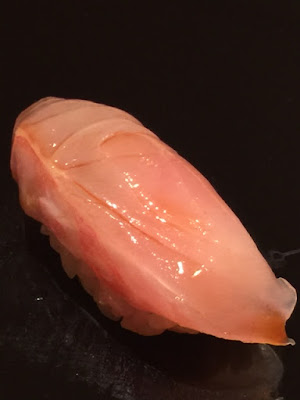

















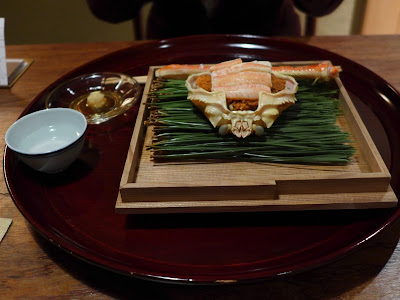




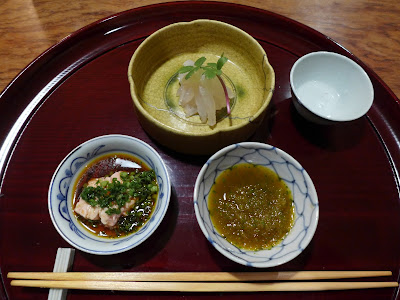















































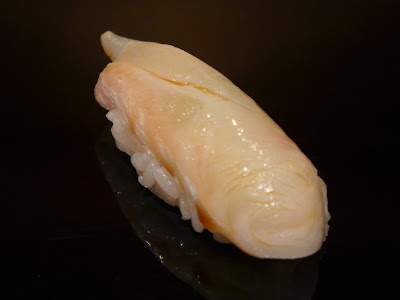




































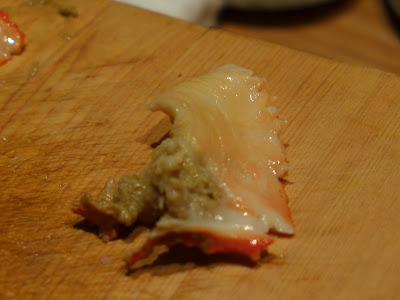




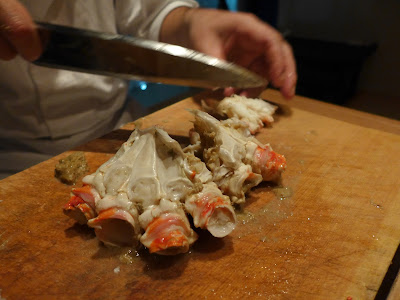









No comments:
Post a Comment